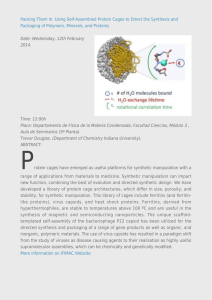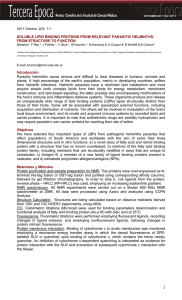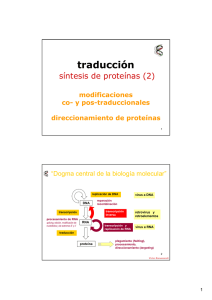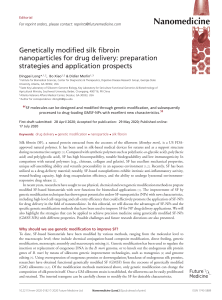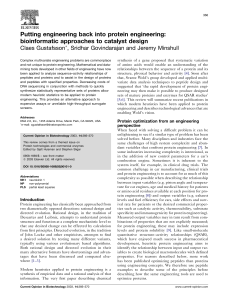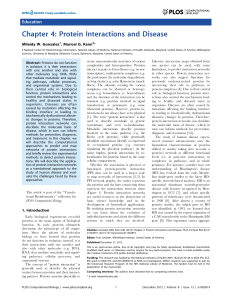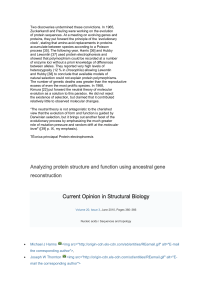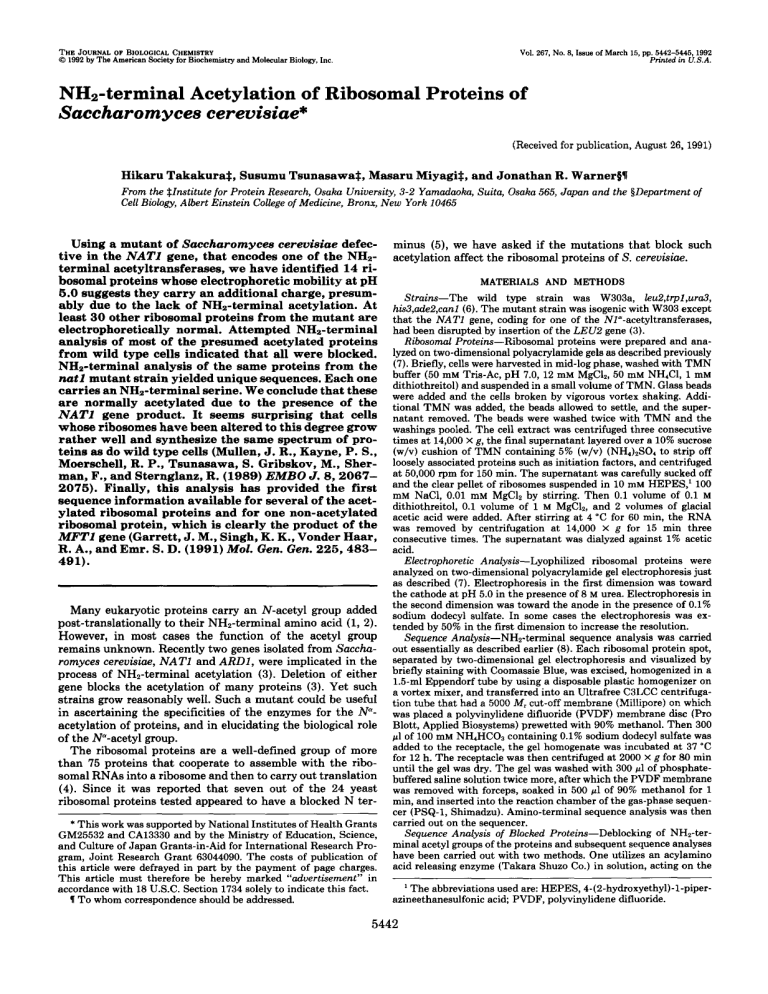
THEJOURNAL OF BIOLOGICAL CHEMISTRY 0 1992 by The American Society for Biochemistry and Molecular Biology, Inc. Vol. 267, No. 8, Issue of March 15, pp. 5442-5445, 1992 Printed in U.S.A. NHa-terminal Acetylation of Ribosomal Proteins of Saccharomyces cerevisiae" (Received for publication, August 26,1991) Hikaru TakakuraS, Susumu TsunasawaS, Masaru MiyagiS, and Jonathan R. Warnergll From the Slnstitute for Protein Research, Osaka University, 3-2 Yamadaoka, Suita, Osaka 565, Japan andthe §Department of Cell Biology, Albert Einstein College of Medicine, Bronx,New York 10465 Using a mutant ofSaccharomyces cerevisiae defec- minus (5), we have asked if the mutations that block such tive in the NATl gene, that encodes one of the NHZ- acetylation affect the ribosomal proteins of S. cereuisiae. terminal acetyltransferases,we have identified 14 riMATERIALS ANDMETHODS bosomal proteins whose electrophoretic mobility at pH 6.0 suggests they carry an additional charge, presum- Strains-The wild type strain was W303a, leu2,trpl,ura3, ably due to the lack of NHz-terminal acetylation. At his3,ade2,canl (6). The mutant strainwas isogenic with W303 except least 30 other ribosomal proteins from the mutant arethat the NATl gene, coding for one of the N1"-acetyltransferases, electrophoreticallynormal.AttemptedNHz-terminal had been disrupted by insertion of the LEU2gene (3). Ribosomal Proteins-Ribosomal proteins were prepared and anaanalysis of most of the presumed acetylated proteins from wild type cells indicated that all were blocked. lyzed on two-dimensional polyacrylamide gels as described previously NHAerminal analysis of the same proteins from the (7). Briefly, cells were harvested in mid-log phase, washed with TMN buffer (50 mM Tris-Ac, pH 7.0, 12 mM MgCI2, 50 mM NHICl, 1 mM natl mutant strain yielded unique sequences. Each one dithiothreitol) and suspended in asmall volume of TMN. Glass beads carries an NHz-terminal serine. We conclude that these were added and the cells broken by vigorous vortex shaking. Addiare normally acetylated due to the presence of the tional TMN was added, the beads allowed to settle, and the superNATl geneproduct.It seems surprisingthat cells natant removed. The beads were washed twice with TMN and the whose ribosomes have been altered to this degree grow washings pooled. The cell extract was centrifuged three consecutive rather well and synthesize the same spectrum of pro- times at 14,000 X g, the final supernatant layered over a 10%sucrose teins as do wild type cells (Mullen, J. R., Kayne, P. s., (w/v) cushion of TMN containing 5% (w/v) (NHJZSOI to strip off Moerschell, R. P., Tsunasawa, S . Gribskov, M., Sher- loosely associated proteins such as initiation factors, and centrifuged man, F., and Sternglanz,R. (1989) EMBO J. 8,2067- a t 50,000 rpm for 150 min. The supernatantwas carefully sucked off 2076). Finally, this analysis hasprovidedthe first and the clear pellet of ribosomes suspended in 10 mM HEPES,' 100 M NaC1, 0.01 mM MgClzby stirring. Then 0.1 volume of0.1 M sequence information available for several of the acet- m dithiothreitol, 0.1volume of 1 M MgC12, and 2 volumes of glacial ylated ribosomal proteins and for one non-acetylated acetic acid were added. After stirring a t 4 "C for 60 min, the RNA ribosomal protein, whichis clearly the product of the was removedby centrifugation a t 14,000 X g for 15 min three MFTl gene (Garrett,J. M., Singh, K. K., Vonder Haar, consecutive times. The supernatant was dialyzed against 1%acetic R. A., and Emr.S . D. (1991) Mol. Gen. Gen.226,483- acid. Electrophoretic Analysis-Lyophilized ribosomal proteins were 49 1). analyzed on two-dimensional polyacrylamide gel electrophoresis just as described (7). Electrophoresis in the first dimension was toward the cathode at pH 5.0 in the presence of 8 M urea. Electrophoresis in second dimension was toward the anode in the presence of 0.1% Many eukaryotic proteins carry an N-acetyl group added the sodium dodecyl sulfate. In some cases the electrophoresis was expost-translationally to their NH2-terminal amino acid (1, 2). tended by 50% in the first dimension to increase the resolution. However, in most cases the function of the acetyl group Sequence Analysis-NH2-terminal sequence analysis was carried remains unknown. Recently two genes isolated from Succha- out essentially as described earlier (8). Each ribosomal protein spot, romyces cereuisiae, NATl and ARD1, were implicated in the separated by two-dimensional gel electrophoresis and visualized by process of NH2-terminal acetylation (3). Deletion of either briefly staining with Coomassie Blue, was excised, homogenized in a Eppendorf tube by using a disposable plastic homogenizer on gene blocks the acetylation of many proteins (3). Yet such a1.5-ml vortex mixer, and transferred into anUltrafree C3LCC centrifugastrains grow reasonably well. Such a mutant could be useful tion tube thathad a 5000 M , cut-off membrane (Millipore) on which in ascertaining the specificities of the enzymes for the Ne- was placed a polyvinylidene difluoride (PVDF) membrane disc (Pro acetylation of proteins, and in elucidating the biological roie Blott, Applied Biosystems) prewetted with 90% methanol. Then 300 pl of 100 mM NH4HC0, containing 0.1% sodium dodecyl sulfate was of the Ne-acetyl group. The ribosomal proteins are a well-defined group of more added to the receptacle, the gel homogenate was incubated at 37 "C for 12 h. The receptacle was then centrifuged at 2000 X g for 80 min than 75 proteins that cooperate to assemble with the ribo- until the gel was dry. The gel was washed with 300 pl of phosphatesomal RNAs into a ribosome and then to carry out translation buffered saline solution twice more, after which the PVDF membrane (4).Since it was reported that seven out of the 24 yeast was removed with forceps, soaked in 500 pl of 90% methanol for 1 ribosomal proteins tested appeared to have a blocked N ter- min, and inserted intothe reaction chamber of the gas-phase sequencer (PSQ-1, Shimadzu). Amino-terminal sequence analysis was then * This work wassupported by National Institutes of Health Grants carried out on the sequencer. Sequence Analysis of Blocked Proteins-Deblocking of NHZ-terGM25532 and CA13330 and by the Ministry of Education, Science, and Culture of Japan Grants-in-Aid for International Research Pro- minal acetyl groups of the proteins and subsequent sequence analyses gram, Joint Research Grant 63044090. The costs of publication of have been carried out with two methods. One utilizes an acylamino this article were defrayed in part by the payment of page charges. acid releasing enzyme (Takara Shuzo Co.) in solution, acting on the This article must therefore be hereby marked "advertisement" in The abbreviations used are: HEPES, 4-(2-hydroxyethyl)-l-piperaccordance with 18 U.S.C. Section 1734 solelyto indicate this fact. azineethanesulfonic acid PVDF, polyvinylidene difluoride. T To whom correspondence should be addressed. 5442 NH2-terminal Acetylation of Ribosomal Proteins 5443 NHQ terminally blocked peptide that has been released by lysylen- into the reaction chamher of the sequencer and sequence analysis of dopeptidase (Wako Pure Chemicals) digestion of the blotted protein, desacetyl protein was carried out. as descrihed previously. (9) The other method, used for most of the determinations, directly analyzes protein theblotted PVDF the on RESULTS AND DISCUSSION membrane (10). Protein adsorbed to PVDF membranes was inserted into1.5-ml a Eppendorf tube and subjected to gaseous trifluoroacetic The proteins Of NAT* and strains are acid for 5 min. The tube containing the membrane was sealed tightly compared in Figs. 1 and 2. Fourteen oft he rihosomd Proteins and allowed to stand at 65 "C for 16 h. The membrane was inserted from the nut2 strain migrate more rapidly in the first dimen- FIG. 1. Ribosomal proteins of NATl and natl strains. Ribosomal proteins were prepared from strains carrying the wild type, NATl ( A ) and the mtI::LEU2 ( R )alleles, and fractionated on two-dimensional polyacrylamide gels as described under "Materials and Methods." Some of the proteins are identified according to the nomenclature originally used with this gel system (31).In two cases, rpl5 and rp6l. where it is now known that a single spot represents two proteins, have been indicated L and R. The asterisk9 denote proteins that,when isolated from the natl strain, have a higher mohility in the first dimension. The same proteins are indicated by arrnwhmd.~ in the gel from the mtl strain (right).Not indicated is rp.52 which also migrates aherrantlv in the mutant cells but which in this figure is poorly resolved from the several proteins in the large spot above rp61. 5444 NH2-terminal Acetylation of Ribosomal Proteins FIG. 2. Extended electrophoresis of ribosomal proteins. As in Fig. 1, except that the electrophoresis in the first dimension has been extended by 50%. Only a portion of the gel is shown. sion (toward the cathode) suggesting that they are more positively charged at pH 5. This behavior is consistent with an additional positive charge at the amino terminus due to the lack of an acetyl group. At most two or three additional proteins may alsobe acetylated, in areas of the gels too crowded for unambiguous identification. The pattern of at least 30 other ribosomal proteins from the mutantis indistinguishable fromthat of the wild type. Most of the proteins with a putative NH2-terminal acetyl group, derived fromthe wild type strain, i.e. rp2,12,14,22,23, 30,39,40,41,50,59,61R, weresubjected to NHz-terminal analysis. All werefound to be blocked. Analysis of the same proteins derived fromthe nutl strainyielded sequenceinformation in all cases. Table I provides NH2-terminal sequence data for most of the apparently acetylated proteins, as well as for a number of other ribosomal proteins. The protein numbering system is that originally used in this gel system (7). Correlation with other systems has been attempted by several groups (11-14). The data in Table I provide definite identifications in some cases.For many of the proteins, however, no sequence data have been reported previously. NHZ-terminal amino acid sequence wasalso determined on the acetylated proteins rp23 and rp30 derived fromwild type cells, as described under “Materials and Methods.” The sequences agreed withthose in Table I. The NH2-terminal sequencesof many yeast ribosomal proteins have been reported (5, 15). In striking confirmation of our observation that normally Nu-acetylatedproteins migrate aberrantly if derived froma nut1 strain, many of the proteins in the lower group of Table I have previously beenidentified by NH2-terminal analysis, while none of the members of the upper group have.Indeed, except for rp2, rp12, rp39,and rp59, that had been cloned and sequenced previously (16-19), the analysis of the proteins from the nutl strainprovides the first sequence data for the N-acetylated ribosomal proteins. The sequence of rp41 is >60%identical to thatof mammalian S11 (20), and thatof rp50 is homologousto mammalian S24 (2123). The improved resolution of Fig. 2 demonstrates that rp14 migrates as two spots. The left portion presumably represents the phosphorylated version of this protein, (24), which also has a phosphorylated counterpart in, mammalian cells (25). Most of the molecules of rp14 appear to be phosphorylated, whether or not they are N-acetylated. Two pairs of acetylated proteins are of interest. Proteins 22 and 23 are adjacent in the gel and both are Nu-acetylated. They have a number of common amino acids at the first 20 residues but differ in some others. Either they are two different ribosomal proteins that share a few amino acids or they are derived from two genes for a single ribosomalprotein that have diverged more than usual (4). Proteins rp30 and rp40 are also adjacent in the gel and both are Nu-acetylated.Their NH2-terminalsequence isidentical, suggestingthat they come from a single gene or from a pair of highly conserved genes. The gene for protein rp40 has been cloned; it was identified by hybrid-selection followed by in vitrotranslation andidentification of the product on a two-dimensional gel (26). No spot correspondingto rp30 was seen in the in vitro translation. Therefore, either the mRNA for protein rp30 is sufficiently different from that of rp40 not to hybridize to the gene for rp40 or else rp30 arises from some post-translational modification of rp40. Sequence analysis and manipulation of the gene for rp40 will be necessary to distinguish the possibilities. It is striking that each of the Nu-acetylated proteins for which we have data has aserine residue at the NH2terminus. Conversely, none of the NH2-terminal sequences obtained in the earlier work (5, 15, 27) started with serine. Only a single protein with serine at its NH2terminus appears not to be Nuacetylated, rpl(L3) (Table I). These facts strongly suggest that the N-acetyltransferase encodedby NATl recognizes primarily an NH2-terminal serine. It has been reported that alanine is a frequent target for Nu-acetylation (28). However, since several of the non-acetylated proteins had alanine at the Nterminus, the NATlenzyme seemsto strongly prefer a serine residue, at least for ribosomal proteins. Little preference for an amino acid adjacent to the terminal serine was apparent. Recent reports havesuggested that S. cerevisiae hasa second Nu-acetyltransferase (NATB), specific foracetylation of NH2-terminal methionine followed by acidic amino acids such as aspartic acid and glutamic acid (29, 30). Thus, the two Nu-acetyltransferaseshave distinct substrate specificities. Since we do not know whether yet other Nu-acetyltransferases with different substrate specificities exist in yeast, we should not rule out the possibility of the existence of additional ribosomal proteins acetylated at their NH2 termini, not apparent in Fig. 1. In summary, we have identified 14 ribosomal proteins that are subject to Nu-acetylation. Surprisingly, the lack of acetylation of these proteins appears to have little impact on the growth rate (3). In our hands the doubling time of the natl::LEU2 strain is only 20% greater than that of the wild type. Furthermore, disruption of NATl has little effect onthe relative rate of translation of different proteins within the NH2-terminal Acetylationof Ribosomal Proteins 5445 TABLE I N-terminal amino acid sequences of ribosomal proteins derived from natl strain Careful comparison of the migration pattern of the ribosomal proteins from the NATl and the nut1 strains, using gels such as those in Fig. 2, suggested that the 12 proteins in the upper part of the table migrated more rapidly in the first dimension. The altered migration is much less apparent for the larger proteins, where the change in charge per unit mass is less. N-terminal sequence was obtained from all of these proteinsas well as from a number of proteins whose migration was unaffected by the NATlphenotype, as described under "Materials and Methods." In a number of cases, as indicated by the references, the N-terminal sequences matched sequences either predicted from the cloned gene or determined previously by N-terminal sequencing of the wild type protein. We were unable to obtain sequence information about proteins 56a and 58, that also appear to be acetylated in wild tvoe cells (Fie. 2). X remesents an unidentified amino acid. Protein no. N" acetvlated rp2 ( i 2 ) rp12 (S4) rp14 rp22 rp23 rp30 rp40 rp39 (L16) rp41 rp50 rp61R rp59 N-terminal sequence Refs. SRPQVTVHSLTGEATANALP SAPEAQQQKR SDTEAPVEVQEDFEVVXEFE SVEPVVVIDGKGLLVGRLAEVVAKQ SQPVVVIDAKDHHLGRLASTIAKQV SAPQAKILSQAPTELELQVAQAEVE SAPQAKILSQ SAKAQNPMRDDKIEKL STELTVQSERAFQKQPHIFN SDAVTIRTRKVISND SAVPSVQAFKKRKVAVAVAKNKANK (major)' (M)SNVVQARDNSQVFGV'.. . (16) (17) (18) b (19) Non-acetylated SHRKYEAPR rpl (L3, YL1) APGKKVAPAPFGAKSTKSN rp6 (L4) GRVIRNQRKGAGSIFTSHTR rp8 (L5, YL6) AVGKNKRLSRGKKGLKKKVV rpl0 AAEKILTPESQLKKSXAQQK r p l l (L6, YL8) VALISKKRKLVADGVFYAXL rp13 (S3, YS3) ANLRTQKRLAASVVGVGKRK rpl5L (L23, YL14) GAYKYLEE rpl5R (L13, YL10) APSAKATAAKKAVVKGTNGK(major)' rp61L (L25) rp41 is clearly homologous to mammalian ribosomal protein S11 (20). * rp50 is clearly homologous to mammalian ribosomal protein S24 (21-23). e We did not carry out N-terminal analysis on RP59. The sequence is predicted from the gene ( 19). Direct N-terminal sequence analysis. e rpl0 is clearly the same protein as thatcoded by the MFTl gene (35). 'The two rp61 spots were slightly cross-contaminated, but the sequences were unambiguous. cell (3).' On the other hand,the regulation of gene expression is somewhat altered in such mutants, e.g. there is partial derepression of the silent mating cassette, and the cells are unable to enter GO when deprived of nutrients (3). (Strathern. J.. Jones. E.. and Broach. J. R.. eds) DD. 529-560. Cold Surine . Harbor Laboratories, Cold Spring Harhor; NY 15. Otaka, E., Higo, K., and Osawa, S. (1982) Biochemistry 21,4545-4550 16. Presutti, C., Lucioli, A., and Bozzoni, I. (1988) J. Biol. Chem. 2 6 3 , 6188- Acknowledgments-We are grateful to Mary Studeny for excellent technical assistance, to Rolf Sternglanz for the natl::LEU2 strain, and toIra Wool and Yuen-Ling Chan for discussion of the ribosomal protein data base. R., Levy, A., Woolford, J., Leer, R. J., van Raamsdonk-Duin, M. M. C., Mager, W. H., Planta, R. J., Schultz, L., Friesen, J. D., Fried, H., and Rosbash, M. (1984) Nucleic Acids Res. 12,8295-8312 19. Larkin, J. C., Thompson, J. R., and Woolford, J. L., Jr. (1987) Mol. Cell. Bid. 7,1764-1775 20. Tanaka, T., Kuwano, Y., Ishikawa, K., and Ogata, K. (1985) J. Biol. Chem. REFERENCES 1. Tsunasawa, S., and Sakiyama, F. (1984) Methods Enzymol. 106,165-170 2. Driessen, H. P. C., dedong, W. W., Tesser, G. I., and Bloemendal, H. (1985) CRC Crit. Rev. Biochem. 18,281-306 3. Mullen, J. R., Kayne, P. S., Moerschell, R. P., Tsunasawa, S., Gribskov, M., Sherman, F., and Sternglanz, R. (1989) EMBO J. 8,2067-2075 4. Warner, J. R. (1989) Microbiol. Reu. 63,256-271 5. Otaka, E., Higo, K., and Itoh, T. (1984) Mol. Gen. Genet. 196,544-546 6. Thomas, B. J., and Rothstein, R. (1989) Cell 56,619-630 7. Warner, J. R., and Gorenstein, C. (1978) in Methods in Cell Biology X X (Prescott, D.,ed) p . 4 5 60, Academic Press, Inc., New York 8. Tsunasawa, S., Kon& J.,and Sakiyama, F. (1985) J. Biochem. (Tokyo) 97,701-704 9. Tsunasawa, S., Takakura, H., and Sakiyama. F. (1990) J. Protein Chem. 9. ?fi!i-?fiK 11.. . ~ ~ ~ ~ d . ' S c U. i . 's ~~ ~ ~~~~ ~ ~ . ~ 13. Ray; H. A., and El-Baradi,T. T. A. L. (1986) in Structure, Function, and Genetics of Ribosomes (Hardesty, B., and Kramer, G., eds) pp. 699-718, Springer-Verlag.New York 14. Warner, J. R. (1982) in The Moleculnr Biology of the Yeast Saccharomyces C. McLaughlin and J. R. Warner, unpublished results. ~ ~ filW 17. Ali-Ribyn. J. A., Brown, N., Otaka, E., and Liebman, S. W. (1990) Mol. Cell. Biol. 1 0 , 6544-6553 18. Teem, J. L., Abovich, N., Kaufer, N. F., Schwindinger, W. F., Warner, J. 260,6329-6333 21. Chan, Y.-L., Paz, V., Olvera, J., and Wool, I. (1990) FEBS Lett. 262,253255 22. Brown, S. J., Jewell, A., Maki, C. G., and Roufa, D. J. (1990) Gene (Tokyo) 91,293-296 23. Klein, H.,Gervais, C., and Suh, M. (1990) Nucleic Acids Res. 18,39973997 24. Zinker, S., and Warner, J. R. (1976) J. Biol. Chem. 251,1799-1807 25. Schubart, U.K., Shapiro, S., Fleischer, N., and Rosen, 0. M. (1977) J. Biol. Chem. 262,92-101 26. Fried, H. M., Pearson, N. J., Kim, C. H., and Warner, J. R. (1981) J. Biol. Chem. 266,10176-10183 27. Otaka, E., Higo, K., and Itoh, T.(1983) Mol. Gen. Genet. 191,519-524 28. Persson. B.. Flinta. C.. von Heiine. G.. and Jornvall., H. (1985) . , Eur. J. Biockm. '162,523-527 29. Lee, F.-3. S., Lin, L.-W., and Smith,J. A. (1990) J. BioZ. Chem. 265,3603" I I 7finfi VU"" 30. Moerschell, R. P., Hosokawa, Y., Tsunasawa, S., and Sherman, F. (1990) J. Biol. Chem. 266,19638-19643 31. Gorenstein, C., and Warner,J. R. (1976) Proc. Natl. Acad. Sci.U. S. A. 7 3 , 1547-1 - - .. -551 -- 32. Schultz, L. D., and Friesen, J. D.(1983) J. Baeteriol. 166,8-14 33. Arevalo, S. G., and Warner, J. R. (1990) Nucleic Acids Res. 18,1447-1449 34. Leer, R. J., van Raamsdonk-Duin, M. M., Hagendoorn, M. J., Mager, W. H., and Planta, R. J. (1984) Nucleic Acids Res. 12,6685-6700 35. Garrett, J. M., Singh, K. K., Vonder Haar, R. A,, and Emr, S. D. (1991) Mol. Gen. Gen. 226,483-491

